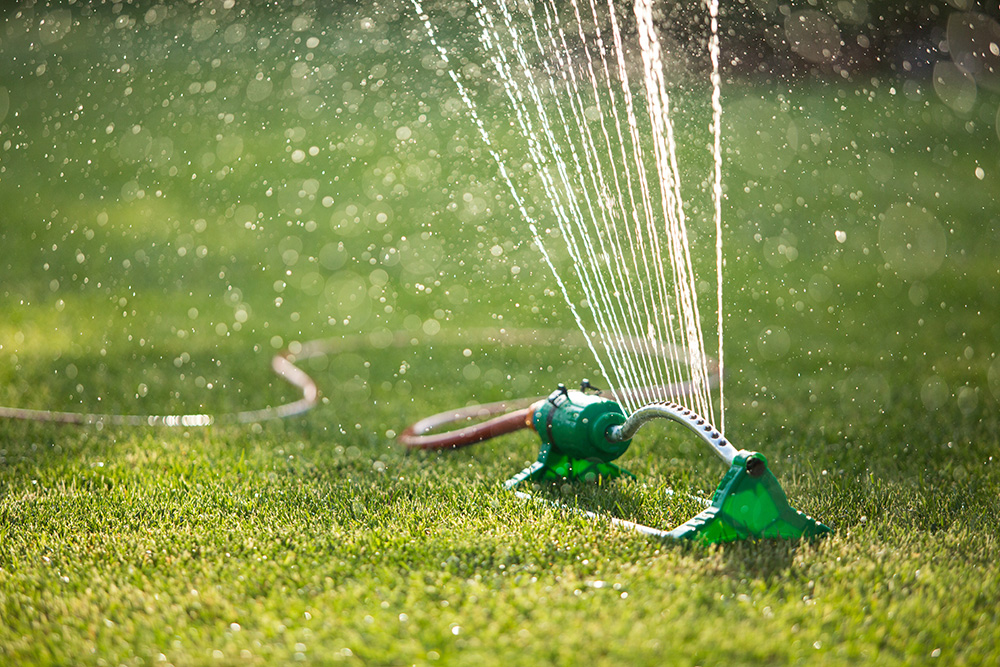One of the key components in maintaining a healthy turf is proper watering. Identifying when your lawn needs water and when it is getting too much is essential. When the lawn does not get enough water, the plant stops growing and goes into dormancy to try to survive. When it has too much water, the plant’s root growth is restricted and causes a general decline in the overall health and growth of the plant. Consistently damp soil helps promote fungus, which is also detrimental to turf grass.
How Often
So how often should you water your lawn? The experts say about an inch a week. In South Carolina and Georgia during the “dog days” of summer, maybe a little more. The challenge is to figure out how much water your specific soil type will take before the water begins to run off. If the water is running off, it doesn’t count toward the inch. Clay soils tend to not accept much water at any one time. It might take 2 or 3 times a week to get 1 inch of moisture. Sandy soils often take as much water as you want to give them, but they do not retain the moisture. Establish your watering times by setting each zone to run until the water begins to run off over most of the area or the first half inch of soil is moist. If you don’t experience runoff and you have watered the lawn a half inch deep, space your watering time to twice a week about a half inch each time. Try to water early in the morning when evaporation is least likely to occur. Avoid watering late in the evening because water sitting on the grass consistently overnight can promote fungus.
A Common Mistake
One of the most common mistakes we see is people setting their irrigation for 15 minutes per zone every day without considering how much moisture is getting into the soil. We had a customer watering in sandy soil for 15 minutes every other day during the afternoon, but they could not figure out why their lawn did not look right. There were 2 problems with the watering schedule. First, the short amount of time – 15 minutes – resulted in shallow root watering, which occurred because they didn’t water enough, so the water just barely wet the surface. This keeps the roots shallow because they try to go where the moisture is. Second, they watered during the afternoon heat, so a lot of water was lost to evaporation.
We modified his watering schedule to 40 minutes per zone twice a week (Sunday and Wednesday) and had the watering start at 4 am. This way there was little evaporation, and the lawn got around a half inch each time. The customer was very satisfied with the results. A word of caution: If your irrigation shares the same water supply as your home, make sure you don’t have your irrigation running when you usually take your morning showers.
What to Look for in Identifying Problems
So how do you identify when your lawn needs water and when it doesn’t? Sometimes the turf will have a silvery grayish color. The leaf blades may look wilted, folded or rolled. Your footprints will remain in the turf for several minutes after you walk through.
Identifying areas that contain too much water is much easier. But understanding why the excessive moisture is present sometimes is more difficult. If the majority of your turf is moist, chances are you are watering too often. If certain areas seem moist while others are dry, your irrigation system may not be uniform in the amount of water it puts out in each zone. If the moist areas are in the lowest parts of your yard, you could be overwatering, and the runoff is collecting in these areas. Some yards just have areas where groundwater and underground streams are very close to the surface, and the only way to eliminate the groundwater moisture is with a French drain system. A Clark’s irrigation specialist or turf care representative can help you troubleshoot your problems.
Install a Rain Sensor
More customers are installing rain sensors to help save money on their water bill and to help prevent overwatering. Rain sensors can be installed for less than $180 and will pay for itself over a year or two when you use city water as your source.
The post Watering Your Lawn appeared first on Clark's.
